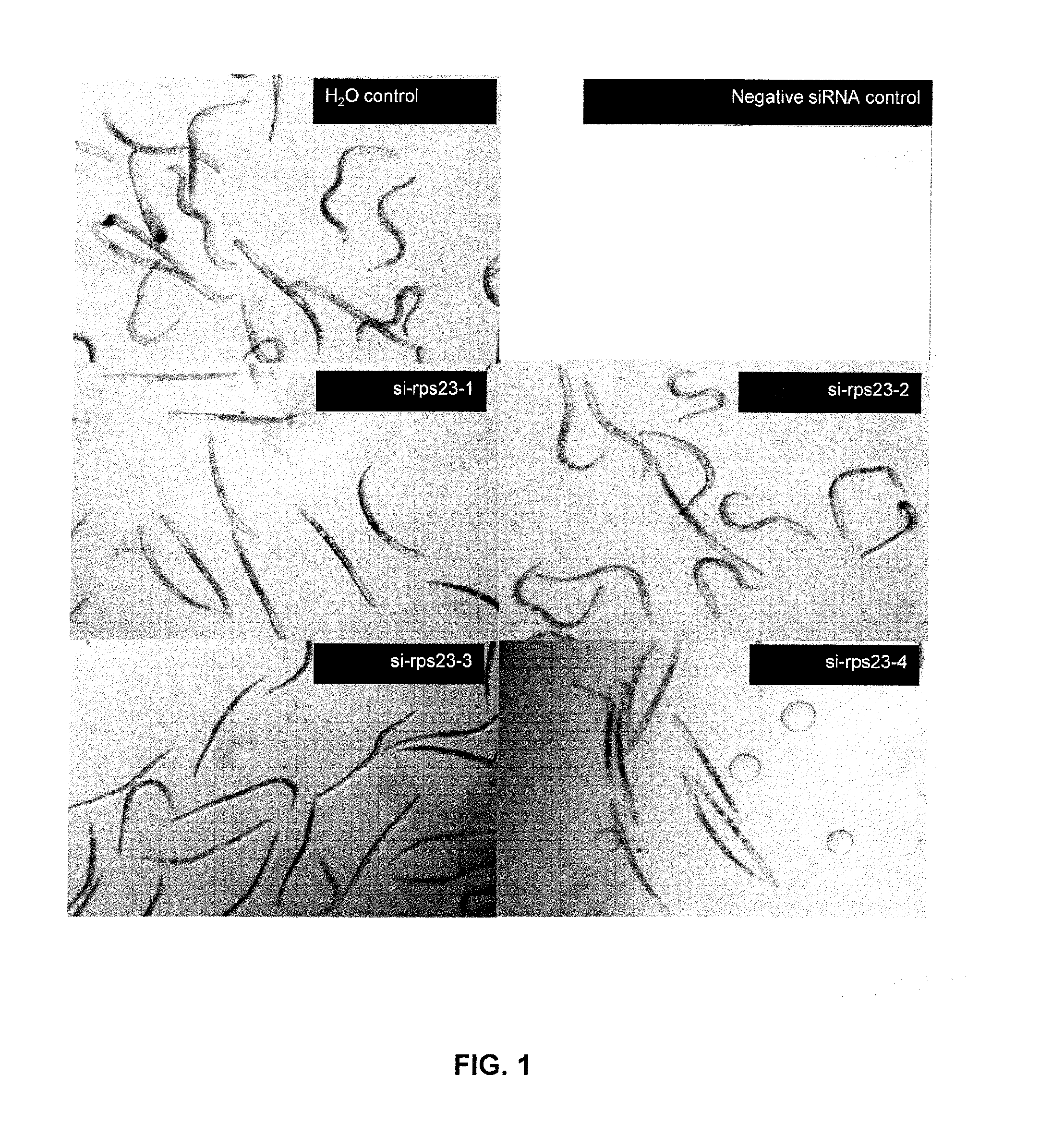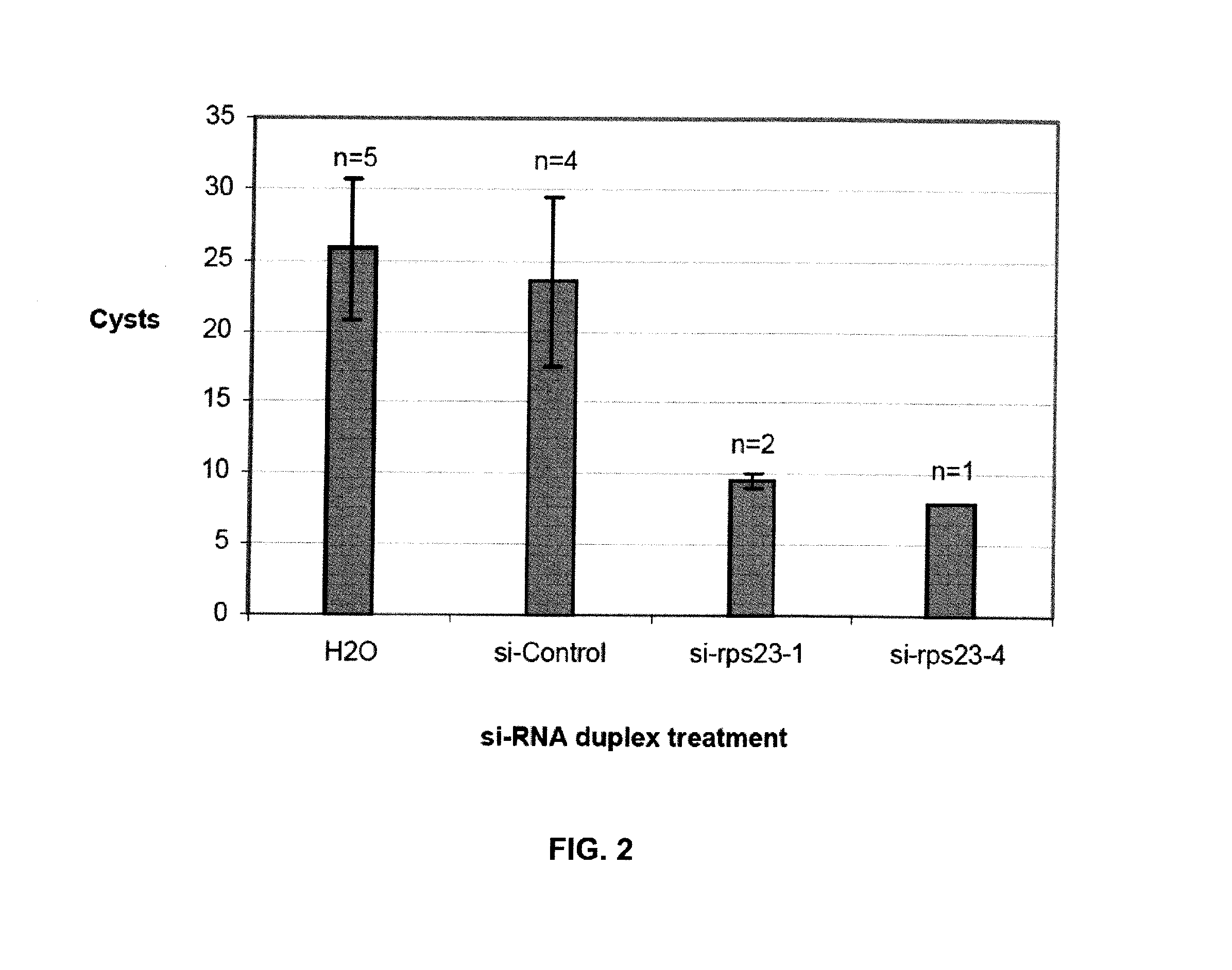Methods and Compositions Using Small Interfering RNA (SIRNA) for Nematode Control in Plants
a technology of nematode parasitism and small interfering rna, which is applied in the direction of biochemistry apparatus and processes, organic chemistry, sugar derivatives, etc., can solve the problems of wilting of plants, inability to eradicate nematode parasitism using known methods, and billion dollar crop losses world-wide, so as to improve crop yield, enhance resistance to nematode infection, and improve crop yield
- Summary
- Abstract
- Description
- Claims
- Application Information
AI Technical Summary
Benefits of technology
Problems solved by technology
Method used
Image
Examples
example 1
siRNAs Targeting Various Regions of The Hg-Rps23 EST
[0150]Summary.
[0151]Four different small interfering RNA (siRNA) duplexes were designed to target various regions of the Hg-rps23 EST (GenBank® Database Accession Number BF014259; SEQ ID NO:931) of the soybean cyst nematode (SCN). The second stage juveniles (J2) of SCN were then soaked in these chemically synthesized siRNA duplexes, followed by subsequent nematode reproduction assay on host plants. Two of the siRNA duplexes were shown to immobilize the J2 and reduce the number of cysts formed on the host plant.
[0152]Experimental Approaches.
[0153]Four siRNA duplexes that target the Hg-rps23 EST of SCN were designed and chemically synthesized. The algorithm was based on the online tool at http: / / www / genelink.com. The sequences of the siRNA duplexes are: 1. si-rps23-1, sense strand: GAAGCGCAAUUUCCGAGAATT (SEQ ID NO:927 with 3′ TT included (Table 3)), antisense strand: UUCUCGGAAAUUGCGCUUCTT (SEQ ID NO:863 with 3′ TT included); 2. si-rp...
example 2
Expression of Artificial microRNAs in Plant Hosts to Silence Target Genes in Pests / Pathogens
[0162]Designing the artificial microRNA. The design of the artificial microRNA (amiRNA) for expression of anti-pest small RNA in plant host cell is as described in Schwab et al. (“Highly specific gene silencing by artificial microRNAs in Arabidopsis” The Plant Cell 18:1121-1133 (2006), the entire contents of which are incorporated by reference herein for teachings of the use of artificial microRNAs), in which amiRNAs were designed to target individual genes or groups of endogenous genes in a plant cell.
[0163]For the studies of this invention, we chose the soybean miRNA precursor gma-MIR164 as the backbone of the amiRNA. The sequence of gma-MIR164 is as follows: agcuccuuguuggagaagcagggcacgugcaagucucuuggaucucaaaugccacugaacccuuugcacgugcuccccu ucuccaacacggguuu (SEQ ID NO:935). The folding structure of the transcript is as follows:
- u u ca --uc -u aucu agc cc uguuggagaag gggcacgugcaag ...
example 3
Nematode Assay on Transgenic Plants Over-Expressing Si-Rps23-1
[0180]The sh-rps23-1 described in Example 1 was transformed into soybean cultivar Williams 82 to produce transgenic soybean plants. This was accomplished by using immature seed targets of variety Williams 82 via Agrobacterium tumefaciens-mediated transformation using explant materials and media recipes as described in Hwang et al 2008 (PCT Publication No. WO / 08112044) and Que et al (PCT Publication No. WO / 08112267) except where noted below. Using this method, genetic elements within the left and right border regions of the transformation plasmid are efficiently transferred and integrated into the genome of the plant cell, while genetic elements outside these border regions are generally not transferred. Maturing soybean pods were harvested from greenhouse grown plants, sterilized with diluted bleach solution and rinsed with sterile water. Immature seeds were then excised from seed pods and rinsed with sterile water briefl...
PUM
| Property | Measurement | Unit |
|---|---|---|
| Electrical resistance | aaaaa | aaaaa |
| Antisense | aaaaa | aaaaa |
Abstract
Description
Claims
Application Information
 Login to View More
Login to View More - R&D
- Intellectual Property
- Life Sciences
- Materials
- Tech Scout
- Unparalleled Data Quality
- Higher Quality Content
- 60% Fewer Hallucinations
Browse by: Latest US Patents, China's latest patents, Technical Efficacy Thesaurus, Application Domain, Technology Topic, Popular Technical Reports.
© 2025 PatSnap. All rights reserved.Legal|Privacy policy|Modern Slavery Act Transparency Statement|Sitemap|About US| Contact US: help@patsnap.com



